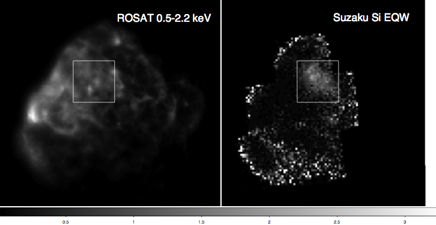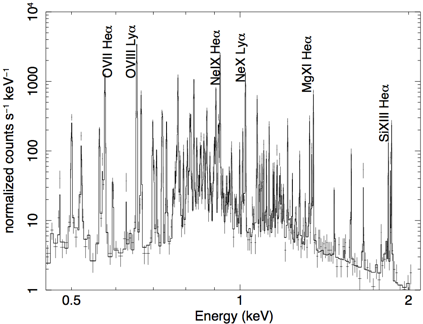The Science of Puppis A

A future Micro-X observation target is the Silicon Knot region of the Puppis A supernova remnant. Puppis A is a bright, middle-aged Galactic supernova remnant, the remnant of a star that exploded approximately 4,000 years ago. Its ejecta is plowing into the surrounding circumstellar medium, which shocks the ejecta and creates a hot (> 106 K) plasma. This plasma emits a rich X-ray spectrum full of lines from atomic transitions which encode the state, composition, and temperature of the plasma. A high energy resolution observation is needed to unravel this complex spectrum. The Silicon Knot (Si Knot) region of Puppis A is particularly interesting because much of the silicon is explosively synthesized.
The improved sensitivity and spectral resolution of the CCDs on the Suzaku X-ray Observatory have led to the identification of a coherent, large-scale ejecta feature in "equivalent width", or line/continuum images, of Si emission in Puppis A. This roughly 8 x 10 arcminute region is located in the north/northeast region of the remnant, somewhat farther out in radius than the optically-identified O ejecta.
The Suzaku observations show that the large ejecta knot can be subdivided into two parts, with the northern half dominated more strongly by Mg and Si than the southern half, in which the O and Ne emission are relatively stronger. The element abundance maps obtained by Suzaku confirm that this entire feature is enhanced not only in Si, but also in O, Ne, Mg, and possibly Fe, all of which have strong lines that will be accessible to Micro-X.
The goals of our Micro-X observation of the Si ejecta knot in Puppis A are to:
- Search for velocity shifts in the various emission lines and measure the line structures to obtain information about the dynamics of the various ejecta elements.
- Perform plasma diagnostics for the various emission lines of individual elements to ascertain how similar or different the thermodynamic states of the various elements are.
- Refine estimates of element abundances in the ejecta.
Velocity and dynamics will give us direct information as to how well-mixed the ejecta are, and in particular, whether there were any differences in the dynamics of the outlying O and Ne ejecta compared to the inner Si and Fe ejecta. Although velocity shift measurements have been attempted with CCD spectra, those moderate resolution spectra do not resolve individual lines so that the energy shift of any particular line is partly obscured by the presence or absence of weak lines in the blend.
The progress to ionization equilibrium depends on both the density of the gas and the shock time. Complexities in the temperature structure are also expected, as a range of temperatures is indicated from Chandra, XMM-Newton, and Suzaku observations. In the case of the hard-to-see Fe L lines, the mere identification of the L lines in the spectrum gives a diagnostic of the range of temperatures in the gas.
Finally, once the dynamical effects and the physical properties of the emitting gas are understood, the high resolution spectrum from Micro-X will provide the means to refine estimates of element abundances in the ejecta. The detailed insights into the temperature and ionization structure are crucial to such an effort. Although the ejecta knot is only a relatively small part of the total ejected material, its large physical scale suggests that it may be a fair representation of the whole. The Micro-X observation would then enable an extremely detailed comparison to nucleosynthesis models for this remnant because it would involve a significant mass of a range of elements.

Simulated 300 second observation of Puppis-A by Micro-X (note logarithmic scale). Micro-X's high resolution clearly separates individual spectral lines, enabling detailed plasma diagnostics.

